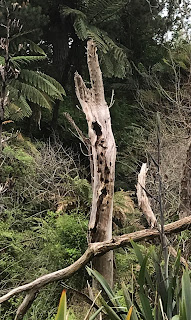Restoration by the community for the community. If you are interested in receiving an email notification every time the blog is updated then register your email on gullyrestoration@gmail.com. Co ordinators are Rex Bushell 854-0973 and Rod Lugton 855-9966 .
Monday, December 9, 2024
NZ praying mantis hatching out
In the urban area of Rototuna, Hamilton, the South African praying mantis species dominates. It is so dominant in fact, that our indigenous one is hardly seen, so it was with surprise and a great deal of satisfaction that our NZ species was observed hatching out down in Mangaiti Gully. This shows that our Gully system is being managed in such a way as to protect our native and indigenous species which is the outcome we are striving for.
Kingfisher nesting tree
The call of the kingfisher is heard throughout the gully at this time of the year. They have very particular nesting requirements, boring holes into either clay banks or rotten tree trunks. As clay banks are rare in the gully, rotten tree trunks are the prime source of nesting. It is therefore important that these are left standing and are not “tidied up” as a perceived eyesore. An old dead twisted willow with a known (by a gully neighbour) active kingfisher nesting hole was cut down recently by a contractor.
Hedgehogs!
Yes, they are cute aren’t they. While we do not have ground nesting birds like on the braided rivers and sea shore, they do put pressure on the invertebrate population, which include tree weta and stick insects and things like our native skinks. From the bi-annual tracking tunnel monitoring they show up in considerable numbers. One Gully neighbour has trapped over eight in only a few months. Check out this link. to an article by Chelsea McGaw from the Forest and Bird magazine. To quote Tom Goodman in this article: ”Hedgehogs are the lawnmowers of invertebrate life. Probably the worst thing about hedgehogs is they pick a patch of real estate and spend their entire life walking around in circles mowing up bugs.” (photo- Predator Free NZ)
Eel infrastructure
Did you know that the longfin eel / tuna is in a significant population decline? If you understand the life cycle, then you can better understand why this is the case. The adults are long lived (60 to 80 years). With species that have such long life spans, the risk is that if the population does not have natural renewal, then the population decline can be very dramatic at the end as the older ones come to the end of their natural life. The days of “lets go eeling kids” are over. Yet another of our indigenous species is at risk.
Education is one way of approaching this problem. Our Trust has invested a considerable amount of time and money to support an education programme. A sign showing the life cycle of the tuna has been erected at the feeding area. The popularity of feeding the eels was putting pressure on the muddy stream bank and our plantings around the area have been trampled into the ground. To resolve this we have built a substantial feeding platform and fenced off the surrounding area of planting.
Natural regrowth is what restoration is all about
There should be a time when planting in a restoration area comes to an end and natural regeneration takes over. It is interesting to see this regeneration occurring in a small area in Mangaiti Gully. The plants identified were:
• Swamp C. tenuicaulis
• Wineberry
• C. Robusta - Karamu
• Mahoe
• Astelia Grandus
• Carex (species unidentified)
• Cabbage tree
Good results from the spring rat monitoring
November saw the bi-annual monitoring of the rat population using tracking tunnels. We have 32 tunnels over the thirty hectares. This is just a snapshot of how things are looking. We recorded only one rat print. However, that does not mean there was only one rat in the whole thirty hectares of Mangaiti, but it does show that the overall population is very low, and we are achieving our stated aim of eradicating all resident rats and controlling reinvasion. Clip on image to enlarge.
Subscribe to:
Comments (Atom)





